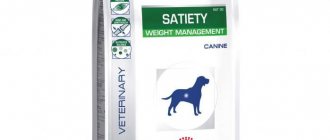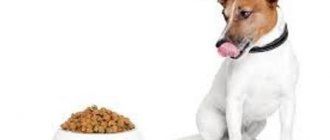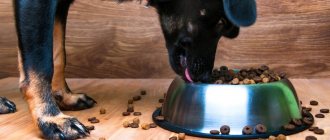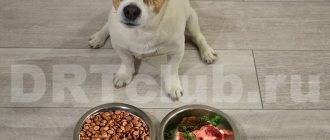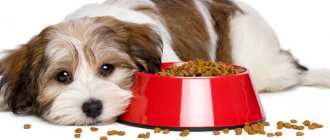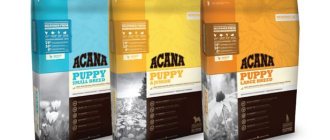Today, dog owners have a wide range of dry food at their disposal. Firstly, it makes life much easier, because you don’t need to rack your brain every day about what to feed your four-legged friend, and secondly, they contain a balance of the substances necessary for the animal’s normal functioning.
In addition to the problem of choosing quality food, dog owners are faced with other issues. For example, exactly how much food to give your pupil every day. You will learn about this from the article.
Dry dog food: advantages
As noted above, many owners of four-legged dogs prefer dry dog food due to:
- ease of use, because you just need to pour it into a bowl, and both the dishes and your hands remain clean;
- balance - provided that you purchase expensive premium varieties that actually contain all the substances your pet needs;
- the opportunity to choose individual nutrition - for sick, small and adult, shaggy and bald, pregnant and lactating, allergy sufferers and hyperactive animals;
- significant savings - both time (no need to look for the necessary products and prepare food) and money (take my word for it, it turns out much cheaper).
Advantages and disadvantages
Examples of diet for puppies of different breeds
Let's take a cocker spaniel puppy as an example. It belongs to small and medium breeds (up to 10 kg). With a current weight of 5 kg, the feeding rate for a cocker will be 130 grams. This is a daily dosage, not a one-time dosage, so it still needs to be divided into 3-5 parts. The younger the puppy, the more often he needs to “refuel”.
A small Labrador of the same weight category (5 kg) needs more food - 160 grams, because it is a large breed (up to 30 kg).
Dry dog food or mixed food: what to choose?
There is an opinion that feeding exclusively dry food can cause your dog to get sick. Therefore, some pet owners prefer the so-called mixed feeding scheme, when the pet is given both dry food and other food - often “human”, what is left from the table.
As a result:
- adding meat to dry food leads to an excess of protein, which overloads the kidneys and provokes renal failure, dystrophic changes in the liver begin, and allergic reactions may begin;
- adding fish leads to an excess of phosphorus, which can cause urolithiasis, affecting not only the liver, but also the stomach, and the level of leukocytes decreases due to minor internal hemorrhages; the amount of calcium in bone tissue begins to decrease, giving way to phosphates, which leads to osteoporosis in adults and rickets in puppies;
- adding cereals leads to an excess of carbohydrates, after which the dog gains excess weight with all the ensuing consequences.
What to eat?
Summarizing the above, we can conclude that a mixed diet is a real terror for the animal’s gastrointestinal system, which can at least provoke gastritis . And only treats, in measured quantities, can be added to dry dog food. For example, a little cheese, boiled meat, dried fruits or crackers.
How to weigh a pet
You can weigh a large puppy on special scales, which are available in every veterinary clinic. In the case of a small puppy, ordinary floor scales will be sufficient: to do this, you need to take the pet in your arms and weigh yourself with it, then repeat the measurement without it and subtract the second from the first indicator. It is advisable to update weight data at least once a month, and if the pet is prone to obesity or, conversely, does not gain weight well on dry food, then weekly.
Dry dog food: the dangers of mono-feeding
- There are many “horror stories” circulating among dog lovers about how the gastrointestinal system of animals suffers from using only dry dog food.
- In fact, troubles can only arise when using cheap economy-class feed, and premium quality drying is a completely different story. After all, before its release, a whole series of studies is carried out in order to best satisfy the dog’s needs. Moreover, manufacturers assume that dog owners will limit themselves only to their products without any complementary foods.
- If you are unsure whether to feed your four-legged friend dry food, consult your veterinarian first. It happens that an animal suffers from some kind of illness that requires some kind of special diet.
What to do if your pet doesn't eat enough
When a puppy eats up the offered food in seconds and looks pitifully, waiting for more, the owner either follows his lead, or holds back, but feels guilty. In fact, moderation in feeding your puppy is part of puppy care and plays a huge role in preventing obesity and related diseases.
In cases where the puppy regularly asks for supplements, first of all you should pay attention to his behavior and build: if he is active and looks well-fed, you should not increase the dosage of dry food.
Allowance for dry food for an adult dog
- To find out the optimal amount of dry dog food that an animal should eat during the day, you can consult a veterinarian, or you can independently calculate it using a tablet, taking into account your pet’s weight and its activity.
Weight and activity
For dogs that lead a different lifestyle from their brothers (participating in competitions, pregnant and lactating, working and hyperactive), the portion should be calculated a little differently.
| Features of the animal | Increasing or decreasing portions |
| Service and participating in competitions | + a third of the serving |
| Pregnant and lactating bitches | + a quarter of the portion |
| Elderly and inactive | - a third of the serving |
Standards for natural nutrition
With natural nutrition, take 40 grams of dry food, the same amount of wet food and fiber per 1 kg of body weight. For pregnant women, service dogs and stud dogs, the amount of natural food can be increased.
With average physical activity, a dog weighing up to 40 kg requires per day in grams:
- meat – 600;
- cereals – 500;
- vegetables – 200-300.
During heavy physical activity, a relative in the same weight category needs (in grams):
- fresh meat – 1000;
- cereals – up to 700;
- vegetables – 300.
For increased physical activity, for a dog weighing more than 40 kg, the following should be used per day (in grams):
- meat – 500;
- cereals – 700;
- vegetables – 400.
It is also recommended to add 50 g of meat and fish bone meal to the diet, from fermented milk products - kefir and fermented baked milk, in a volume of 100-200 ml, cottage cheese - from 200 to 500 g.
Calculate the amount of dry dog food yourself
Knowing the energy value of the dry dog food that you plan to feed your pet (indicated on the package), calculate how much you will need to give it to your dog daily, taking into account the required amount of Kcal per kilogram of live weight per day.
Standards for puppies and adult dogs
- They are young, growing organisms, so they need to be fed more often and more abundantly than adult dogs.
- That is, babies from one and a half to three months old should be given a double dose of food compared to an adult of the same breed, from three months to six months - the portion is half larger; from six months to 11 months – increased by a third.
If you feed your four-legged friend exclusively dry dog food, he will need much more water. It is believed that the average dog needs approximately 50 ml of water per kilogram of weight per day.
Ideally, the animal should have as much water as needed and freely available, because the level of thirst can fluctuate, for example, due to air temperature, level of activity, and health.
Don't forget about water after feeding your dog
The food can be soaked in warm, clean water (alternatively, natural yogurt or low-fat kefir), if there are no restrictions on this on the packaging, in proportions of 1 to 2 or 1 to 3. Soak the food most often for puppies, adults with oral diseases or elderly animals. Attention: you cannot store soaked dry food for more than a couple of hours to avoid souring.
Other articles about animals:
- If a dog bites a person, what threatens the owner?
- Eosinophilic myositis of the jaw in dogs
- Dogs that won't listen to another owner
- The strongest, smartest, dangerous dog breeds
- Doberman or German Shepherd - which dog is better?
Diet by age and weight
If you take a small puppy into your home, then each feeding should be strictly on schedule, at least every 4 hours. If this rule is followed, the baby’s diet is established, which has a positive effect on the functioning of the digestive system.
Gradually, the periods between feedings increase; nighttime intake is best done after 6 hours. When the pet reaches six months or older, it is fed every 5 days during the day. A one-year-old dog is considered an adult and is fed 2 times a day.
To avoid digestive problems:
- the dog should rest one hour before meals and one hour after;
- You can’t play active games during rest, especially after eating;
- it is necessary to feed the animal in a calm environment;
- Keep the bowl clean, promptly removing all residues from it.
Wet food
Soft canned food has exactly the same division into classes as dry food. This means that the higher the class of food, the greater its energy and nutritional value, which means that less of it will be needed to saturate.
However, it is not recommended to completely switch the animal to feeding canned foods - soft food can cause problems with the gastrointestinal tract, constipation or loose stools, and the risk of tartar formation increases, since there is no mechanical cleaning of plaque.
| Type of dog | Daily calorie requirement (kcal) | Combined diet (dry + wet) (g) Pedigree | Only wet (100%) (gr) Using Pedigri as an example |
| Miniature (2-5 kg) | 250-350 | 40-50 | 300-400 |
| Small (6-10 kg) | 360-550 | 50-100 | 400-700 |
| Medium (12-24 kg) | 600-1050 | 100-250 | 800-1300 |
| Large (26-40 kg) | 1100-1550 | 200-300 | 1400-2000 |
| Very large (45+ kg) | 1600-2500 | 300-550 | 2050-6000 |
How to cook dog porridge with meat
From experience, we can say that for proper nutrition, you need to feed your dog porridge with meat 2-3 times a week. Pearl barley, oatmeal, and wheat porridge will bring benefits, but buckwheat is the most beneficial. It contains many useful minerals, and besides, it helps the dog lose weight and cleanses the circulatory system.
Therefore, next we will describe the process of preparing buckwheat dog porridge. Preparing such a dish is not difficult. In the evening, pour cold water over buckwheat and leave overnight. To cook porridge, you will need to take 1 part buckwheat and add 2 parts water. This porridge is cooked for 15 minutes, after which it is infused in the pan for the same amount of time.
During the cooking process, you can add chopped meat to the porridge. Before adding to the porridge, the meat must be boiled to prevent possible infection of your pet. The total volume of meat should be approximately 1/3 of the volume of porridge.
Many dogs love to crunch on cucumbers.
As for additives and seasonings, it is advisable to avoid adding salt to porridge, but a teaspoon of vegetable oil will be very useful.
Table of daily norms and needs of different dogs
In order to determine the size of the food portion, you first need to know the dog’s weight, at least approximately. Regularly weighing your pet will help adjust this norm to a comfortable value so that the dog does not overeat and is full at the same time.
If we know the dog’s weight, we can use a table of daily food intake - such a table is always published on the official pages of food brands on the Internet and, of course, on each package. As an example, consider Blitz Adult Lamb & Rice food for all breeds.
| Dog weight | Recommended norms for low activity, g/day | Recommended norms for high activity, g/day |
| 1 kg | 20-35 | 30-40 |
| 3 kg | 45-55 | 50-70 |
| 5 kg | 75-90 | 80-120 |
| 10 kg | 125-150 | 145-170 |
| 15 kg | 175-200 | 190-240 |
| 20 kg | 220-260 | 250-300 |
| 30 kg | 280-350 | 330-400 |
| 40 kg | 380-440 | 430-500 |
| 50 kg | 450-525 | 520-590 |
| 60 kg | 520-605 | 600-670 |
| 70 kg | 580-680 | 670-770 |
| 80 kg | 650-750 | 740-850 |
In his table, in addition to weight, there is also an indicator such as activity, which must also be taken into account. After all, a dog with the same weight may have different energy needs: a 10-kilogram dog kept in apartment conditions will need 130 grams of food per day, but an active, mobile dog with the same weight will need more to replenish energy costs. 150–170 grams.
The nutritional needs of puppies and older dogs differ. During the period of active growth, puppies require a colossal amount of energy, so the easiest way is to use dry food from the Puppy series, which has a higher calorie content than food for adult dogs, for example Blitz Puppies Fresh Duck & Chicken.
The energy needs of aging dogs are much more modest than those of young dogs. Age-related changes, which include a slowdown in metabolic processes, make the dog less active and prone to weight gain. It is not necessary to look for special food for older dogs; besides, older pets often have established eating habits and may react negatively to a new taste. It is enough to simply slightly reduce the daily intake of your usual dry food.
When does a dog need extra nutrition?
There are situations when your pet is not only allowed, but even recommended to feed food in excess of the amount specified by the manufacturer:
- during gestation and feeding of puppies. For pregnant dogs, 25–50% is added to the usual dosage of dry food, and for nursing dogs, there is no dietary restriction at all. During this crucial period, underfeeding is much more dangerous than overeating;
- in winter cold when kept outdoors or in an unheated room. In this case, it is advisable to increase the norm by 10–20% of the recommended;
- with underweight. If the problem is due to poor living conditions (for example, the dog has gone through a period of malnutrition), it is permissible to temporarily increase the dosage of dry food. If your pet begins to rapidly lose weight despite normal feeding, it is reasonable to contact a veterinarian to rule out diseases and only then adjust the norm.
Table of foods recommended for feeding dogs
Let's move on to the table of products recommended by the international BARF nutrition system for animals:
- Raw meat : lamb, horse or beef, chicken, turkey and rabbit meat. The presence of cartilage, films and veins is allowed in the meat.
- Bones : beef tails, bird heads and necks (necessarily without beak).
- By-products : heart, brain, lungs and tracheas, beef trimmings and poultry offal.
- Fish : river and sea fish. Sea fish (cod, mackerel, halibut and others) should be a priority, because... it has the highest content of phosphorus and Omega-3 fatty acids. It is best to give your dog fish food twice a week.
- Vegetables : broccoli and cauliflower, carrots and zucchini, cucumbers, pumpkin and bell peppers. Vegetables can be given either raw or boiled.
- Greens : parsley, lettuce, seaweed and dandelion leaves.
- Berries and fruits : bananas, apples and pears, blueberries, blueberries and watermelon. This food can be used as a treat.
- Eggs. It is recommended to give dogs exclusively egg yolk, no more than 1-2 times a week.
- Fermented milk products : cottage cheese and kefir, natural yogurt and yogurt.
- Oils : burdock, linseed and olive oil.
Important! There should be equal amounts of bones and meat in a dog’s diet. It is advisable to feed your dog these products raw.
Important! If your pet refuses raw vegetables, try boiling or stewing them a little. Perhaps then your pet will like them.
Bones are best given raw.
Important! The BARF system does not recommend feeding your pet cereal. However, if you do not want to strictly adhere to this system, you can sometimes give your pet boiled pearl barley, buckwheat or rice.
Feeding frequency
The volume of food consumed and the number of meals depends on the age of the animal. For a puppy, feeding frequency should be frequent. This is due to the fact that small pets are highly mobile, they spend a lot of energy, and to replenish it they need a large amount of nutrients, which come with food.
In order to feed dogs correctly, it is worth studying the table below, which shows the frequency of feedings depending on the age of the animal.
| Dog age | Number of feedings |
| 1 to 2 months | You need to feed up to 5-6 times a day |
| 2 to 3 months | Feed 4-5 times a day |
| 4-6 months | You should feed no more than 3-4 times a day |
| From 6 months to 1 year | No more than 3 meals per day |
| Dogs over 1 year old | Adult animals eat twice a day - morning and evening |
What is the relationship between the class of feed and its consumption?
A dog owner should know how to properly feed his pet dry food. There are many different factors to consider and remember that there is no single standard. Even dogs of the same breed require different amounts of food.
A variety of dry food allows you to choose the one that suits your pet best
The amount of feed directly depends on its category. A cheap product has an average composition, it contains few useful substances, it will be digested faster, therefore, the dog needs to be given a larger portion so that it does not remain hungry.
More expensive foods contain more nutrients and fill you up faster. As a result, the dog feels full for a longer time; a small portion is enough to satiate him.
For your information! More expensive products have a better effect on the dog's body, especially during adolescence.
How much water do you need
In order for the dog’s body to fully absorb all the nutrients from the food it eats, it must be given water every day. It is the basis for proper metabolism and normal digestion.
Recommendations for calculating the required volume of water:
- the daily water intake is calculated depending on the weight of the pet;
- For approximately 1 kilogram of the weight of an adult tailed cat, 40-60 ml of water is required;
- small puppies need more water - 80-110 ml per kilogram of body weight;
- if the dog eats only dry food, then it may need more liquid;
- if the ambient temperature is less than 25 degrees Celsius, then the dog may need less water per day.
Note! When calculating the required amount of liquid, it is worth taking into account not only ordinary water, but also the presence of liquid in the food the dog eats - cereals, soups, vegetables, meat, dairy products.

